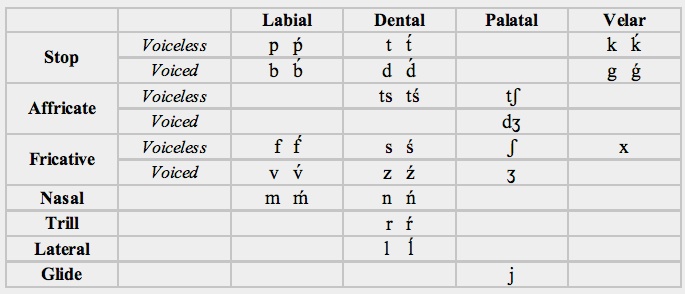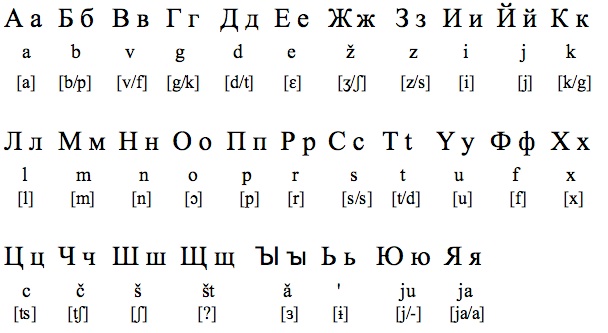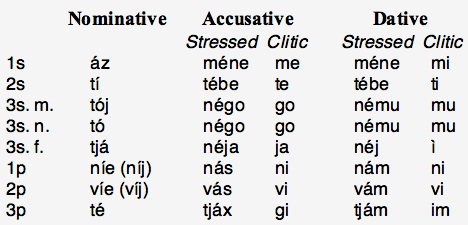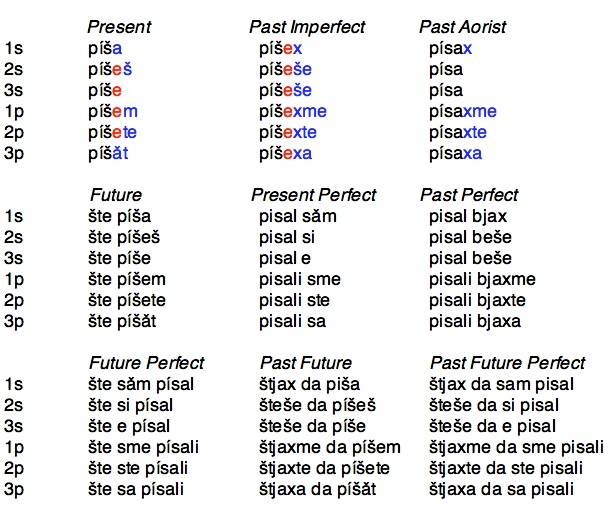Bulgarian Language



An insatiable appetite for ancient and modern tongues
Address comments and questions to: gutman37@yahoo.com
Classification: Indo-European, Slavic, South Slavic. Other South Slavic languages are Serbo-Croat, Macedonian and Slovenian.
Overview. Bulgarian emerged more than a millennium ago when the Slavs, who had arrived in the middle of the 1st millennium AD to the eastern Balkan Peninsula, were conquered by the Bulgars. The newcomers established the First Bulgarian Kingdom (681-1018) and, even if they were ethnically Turkic, adopted the language of their Slavic subjects. The geographical and political isolation from other Slavs led these Southern Slavs to developed their own dialects.
Bulgarian was first attested in the late 9th century as a literary language, known as Old Church Slavonic, developed by the monks Cyril and Methodius to translate religious texts from Greek. It was based on different local dialects and, hence, had two varieties: the Eastern one is considered to be Old Bulgarian while its western one is considered to be Old Macedonian. In the Medieval period, from the 12th to 15th centuries, the language experienced radical changes, particularly the loss of noun declension, which paved the way to Modern Bulgarian.
The modern language is very close to Macedonian, both have (almost completely) lost all case declensions, and both have been influenced by Balkan non-Slavic languages, like Greek, Albanian and Romanian, as shown by certain features found in them but not in other Slavic languages. For example, Bulgarian, like Romanian and Albanian, has a schwa-like central vowel in stressed syllables, a postposed definite article, and lacks an infinitive which is replaced by a subordinate clause (this also happens in Modern Greek).
Distribution. Bulgarian is the mother tongue of about 85 % of the population of Bulgaria which has been declining steadily (7.36 million inhabitants according to the 2011 census). It is also spoken in parts of neighboring countries, particularly in Serbia (Dmitrovgrad and Bosiljgrad districts), Greece (Western Thrace), and Turkey (Edirne and western provinces). Besides, there are sizable Bulgarian-speaking minorities in Moldova, and Ukraine.
Speakers. About 7.3 million in the following countries: Bulgaria (6.3 million), Moldova (0.4 million), Turkey (0.3 million), Ukraine (0.25 million), Serbia (60,000), Greece (30,000).
Status. Bulgarian is the only official language of the Republic of Bulgaria.
Varieties. There is a literary language spoken only on formal occasions, and several colloquial dialects which can be grouped into Western and Eastern, separated by a vertical line (the jat line) running through the city of Pazardzhik. This line marks the difference in pronunciation of the Old Slavic jat vowel which became ja in a stressed syllable followed by a back vowel in the Eastern dialects and e in Western ones. The south-eastern dialects, found in the Rhodope mountains, are the most archaic. The western dialect of the capital, Sofia, is becoming the standard oral language.
The standard literary language was based initially on the north-eastern dialect of the city of Tárnovo, Bulgaria's first capital, but with the shift of the capital to Sofia in 1879, it adopted also some features of the local dialect.
Oldest Documents. They are the translations from Greek by the brothers Cyril and Methodius continued by their disciples leading to the "Golden Age" of Bulgarian literature under Tzar Simeon (893-927). Among many works, we found:
-Shestodnev (Hexameron) by John the Exarch. Created on the basis of older Byzantine essays tells the story about the creation of the world (hence the title meaning "six days") including passages on astronomy, geography, and history.
-Zlatostruy (Golden River) by Tsar Simeon I, a collection of excerpts from the sermons of St. Chrysostom and St. Epiphanius of Cyprus.
Periods
9th–11th centuries: Old Bulgarian is only attested as Old Church Slavonic, a highly inflected literary language employed to translate religious texts from Greek, in the First Kingdom of Bulgaria.
12th–15th centuries: Middle Bulgarian experienced radical phonological and morphological changes (e.g. loss of noun declension). It is attested in many literary works.
15th c.-present: Modern Bulgarian. From the early 15th century until 1878, Bulgaria was under Turk Ottoman domination when the language was neglected. Afterwards, it experienced a revival when it was purged from many Old Church Slavonic, Russian, and other foreign words.
Phonology
Vowels (6). Modern Bulgarian has six stressed vowels. The mid-central one is very close to a schwa which is found in some Balkan languages, like Romanian and Albanian, but not in other members of the Slavic branch. When a vowel is followed by a nasal consonant and a fricative, it is nasalized. Vowel sequences are possible only across morpheme boundaries.

Consonants (36). Bulgarian has, like all Slavic languages, palatalized consonants (marked here with an accent). The only non-palatalized consonant is the velar fricative.

Stress. It may fall on any syllable and with derivation and inflection its position may change. Stressed vowels are longer and stronger than unstressed ones, the latter when in word-final position are generally voiceless. Only one syllable is stressed, but compound words may have a secondary stress.
Script and Orthography. Bulgarian is written with the Cyrillic alphabet; its transliteration in the Latin alphabet is shown immediately below it while the International Phonetic Alphabet equivalents figure between brackets.

Morphology
-
Nominal
-
•gender: masculine, feminine, neuter. Gender is natural for nouns representing humans though some nouns referring to young people are neuter. Animal nouns do not usually specify sex and are, arbitrarily, masculine or feminine; young animals can be referred to by using a neuter noun. The gender of objects or concepts corresponds frequently with their endings: masculine nouns end usually in consonant, neuter nouns in o or in e, and feminine ones in a (or ja after a palatalized consonant or a vowel). However some masculine nouns end in a vowel (o/e/a), and some feminine ones in a consonant (many are abstract and end in ost). Some neuter nouns, mainly borrowed words, may end in other vowels (e.g. menjú, taksí).
-
•number: singular, plural. Most masculine monosyllabic stems make their plurals by adding the suffix -ove, while masculine polysyllabic stems pluralize with -i (those ending in -in loose it before adding -i). Masculines ending in a/ja make their plurals with -i, irrespective of the number of syllables, and those ending in -o pluralize with the suffix -vci. A number of exceptional monosyllables make their plurals with -i instead of -ove.
-
Regular feminine nouns make their plurals by adding -i, regardless of their singular ending (if they end in a vowel this is replaced by the plural suffix). If the noun has vowel-zero alternation the vowel is lost in the plural. Typically neuter nouns make their plurals by replacing the singular ending with -a/ja.
-
Masculine nouns
-
1) sín ('son') ➞ sinové
-
2) ád ('hell') ➞ ádove
-
3) nérv ('nerve') ➞ nérvi
-
4) učítel ('teacher') ➞ učíteli
-
5) véstnik ('newspaper') ➞ véstnici
-
6) bǎ́lgarin ('Bulgarian') ➞ bǎ́lgari
-
7) baštá ('father') ➞ baští
-
8) tátko ('dad') ➞ tátkovci
-
1-2) regular monosyllables add -ove, 3) some exceptional monosyllables add -i,
-
4-5) regular polysyllables add -i, 6) nouns ending in -in replace it by -i,
-
7) nouns ending in -a replace it by -i, 8) nouns ending in -o add -vci
-
Feminine nouns
-
žená ('woman') ➞ žení
-
sestrá ('sister') ➞ sestrí
-
párt ('part') ➞ párti
-
nóšt ('night') ➞ nóšti
-
pésen ('song') ➞ pésni
-
1-2) the vowel ending is replaced by -i, 3-4) nouns ending in consonant add -i,
-
5) loss of vowel in nouns with vowel-zero alternation
-
Neuter plural
-
sǎrcé ('heart') ➞ sǎrcá
-
licé ('face') ➞ licá
-
tjálo ('body') ➞ telá
-
ágne ('lamb') ➞ ágneta
-
momčé ('boy') ➞ momčéta
-
moré ('sea') ➞ morjya
-
1-3) the vowel ending is replaced by -a, 4-5) some nouns ending in e add -ta,
-
6) palatalization of final consonant
-
•case: there is an almost complete loss of case declension in the noun though some nouns and masculine singular adjectives have vocative forms, marked by suffixes. For example, the vocative singular of the masculine noun grád ('city') is made by adding -e (gráde) and its vocative plural by adding -a (gráda). Vocative of feminine nouns is made by replacing the final vowel by -o or -e: žená ('woman') ➝ žéno. The regular vocative suffix for singular adjectives is -i: nóv ('new') ➝ nóvi.
-
There are subjective and objective contrastive forms for the masculine singular definite article. Personal pronouns have more cases, including nominative, accusative and dative.
-
•adjectives: agree with the nouns they modify in number, and gender (only in the singular), e.g. 'new': nóv (masc. sg.), nóva (fem. sg.), nóvo (nt. sg.), nóvi (plural).
-
By employing a preposed stressed particle, comparative and superlative adjectives can be formed. The particle pó- is used for comparatives and náj- for superlatives, e.g. pó-nóv ('newer') and náj-nóv ('newest'). Adjectives may take the definite article in definite noun phrases.
-
•pronouns: personal, reflexive, demonstrative, interrogative-relative, indefinite.
-
Personal pronouns have three possible cases (nominative, accusative, and dative), and distinguish gender in the 3rd person singular. There are stressed and clitic (unstressed) forms. Stressed accusative forms are used with prepositions and as direct object. Stressed dative forms are archaic and have been replaced now by prepositional phrases. Clitic forms, accusative and dative, are used as direct object and indirect object, respectively.

-
Possessive pronouns distinguish person of the possessor, and number, and gender of the possessed (only in the singular):

-
The reflexive pronoun has stressed, clitic and possessive forms. The stressed accusative and dative is sébe si, the clitic accusative is se, and the clitic dative is si. Its possessive forms (translated as 'own') are: svój (masc. sg.), svóe (nt. sg.), svója (fem. sg.) and svói (plural).
-
Demonstrative pronouns have three different forms corresponding to 'this', 'that' and 'such a', and distinguish gender and number:
-
'this': tózi/tója (masc. sg.), tázi/tája (fem. sg.), tová/túj (nt. sg.), tézi/tíja (plural).
-
'that': ónzi/ónja (masc. sg.), onázi/onája (fem. sg.), onová/onúj (nt. sg.), onézi/oníja (plural).
-
'such a': takắv (masc. sg.), takáva (fem. sg.), takóva (nt. sg.), takíva (plural).
-
Interrogative pronouns also distinguish gender and number, except 'what'.
-
'who?, which?': kój (masc. sg.), kója (fem. sg.), koé (nt. sg.), koi (plural). There is an accusative form for the masculine singular (kogó), also present in other pronominal forms derived from it, employed as direct object and object of prepositions; the dative is formed with the preposition na plus kogó.
-
'what?': kakvó/štó. It only has this neuter singular form.
-
'whose?': číj (masc. sg.), čijá (fem. sg.), čié (nt. sg.), číi (plural).
-
The main interrogative adverbs are kák ('how?'), kǎdé ('where?'), and kogá ('when?').
-
Relative pronouns are formed by suffixing -to to the interrogative pronouns, e.g. kójto ('who, which, that').
-
Negative pronouns are formed by prefixing ní- to the interrogative pronouns, e. g. níkoj ('no one'), níšto ('nothing').
-
Indefinite pronouns are formed with njá/né plus an interrogative, e. g. njákoj ('someone'), néšto ('something'). Other indefinite pronouns are formed by adding èdi to an interrogative one.
-
•definite article: is postposed (attached to) the first constituent of a definite nominal phrase, be it a noun or and adjective. In the written language, masculine singular nouns have long nominative (-ǎt/jat) and short object forms (a/ja), e.g. učíteljat ('the teacher'). In the spoken language there is a tendency to use the short form in all cases. The feminine singular is -ta, e.g. ženáta ('the woman'), and the neuter singular is -to, e.g. mjástoto ('the place'). The plural article is -te for words ending in a or ja, or -ta for words ending in -i/-e.
-
Verbal
-
The Bulgarian verbal system, in contrast to that of other Slavic languages, is comparatively complex having more moods and tenses.
-
•persons and numbers: 1s, 2s, 3s; 1p, 2p, 3p. Compound verb forms distinguish gender in the singular (masculine, feminine, neuter).
-
•aspect: imperfective, perfective. The imperfective expresses an incomplete or ongoing action, the perfective a completed one. Perfective verbs usually derive from imperfective ones by adding a prefix to it which may not only change its aspect but also its meaning. Conversely, it is possible to derive an imperfective verb from a perfective one by suffixation. Most Bulgarian verbs come, then, in imperfective-perfective pairs, e.g. imperfective píša ('I write')- perfective napíša ('I finished writing').
-
•tense: present, present perfect, past imperfect, past aorist, past perfect, future, future perfect, past future, past future perfect.
-
The indicative mood has these nine tenses of which the present, past imperfect, and past aorist are simple while the rest are compound.
-
The present is formed by adding a vowel (e/i/a) to the present stem, except for the 1sg and 3p, followed by personal endings (1s: -ǎ, -m; 2s: -š; 3s: -ø; 1p: -m, -me; 2p: -te; 3p: -ǎt).
-
The past imperfect expresses actions subordinate or contemporaneous to other actions occurred in the past. It is formed with the present tense stem plus a vowel (e, á) followed by past personal endings (1s: -x; 2s: -še; 3s: -še; 1p: -xme; 2p: -xte; 3p: -xa).
-
The past aorist expresses a temporally independent past action. It is formed with the aorist stem followed by past personal endings except for the 2s-3s which have no ending.
-
The paradigm of the verb piša ('to write') which belongs to the first conjugation is:

-
The future tense is formed with the proclitic auxiliary šte plus present tense.
-
The present perfect expresses an action completed in the past which is relevant to the present. It is made up with the aorist past active participle + present of verb 'to be'.
-
The past perfect expresses an action completed in the past related to another past action. It is formed with the aorist past active participle + past imperfect of verb 'to be'.
-
The future perfect expresses an action that will be completed in the future before another future action. It employs the future tense of 'to be' + aorist past active participle.
-
The past future is used for an action that will be completed in the past being future in relation to another past action. It is formed with the imperfect past of štjá + particle da + present tense of the lexical verb.
-
The past future perfect expresses a past action which is in the future in relation to a past action, which itself occurred before another past action. Formed with the past future of štjá + aorist past active participle.
-
•mood: indicative, imperative, conditional, presumptive.
-
The indicative expresses statements or facts; as we have seen it has three simple and six compound tenses. The imperative is used for commands and has also simple and compound tenses. The conditional denotes possible or hypothetical events, and has only compound forms. The presumptive is employed to narrate facts not personally witnessed by the speaker, and has only compound forms.
-
The simple imperative has only 2nd person. The singular is formed with the present stem + i/ø in the singular (piší), and the plural by adding e/ø + te (pišéte). The compound imperative has all persons and numbers, and is formed by the particles da or néka plus the present tense (e.g. néka áz píša = 'let me write!'). The imperative can be formed from perfective or imperfective verbs.
-
-
The conditional is made up with the past aorist of the verb ‘to be’ (stem bi-) + aorist past active participle: 1s bix pisal, 2s bi pisal, 3s bi pisal, 1p bixme pisali, 2p bixte pisali, 3p bixa pisali.
-
-
The presumptive is formed with the present tense of 'to be' + an aorist or imperfect past participle.
-
•voice: active, passive, reflexive.
-
Passive constructions may use:
-
a) the past passive participle of a transitive verb combined with any tense of the verb 'be'.
-
-
b) the accusative reflexive pronoun (se) plus a 3rd person form of a transitive verb. This type of passive is the most widespread.
-
-
c) impersonal finite forms (3rd person plural) of transitive verbs.
-
Reflexive verbs take the clitic form of the accusative reflexive pronoun (se). Its forms are used in impersonal constructions in the 3rd person singular with transitive and intransitive verbs. Intransitive verbs are, in many cases, reflexive.
-
•non finite forms: gerund, present active participle, past active participle, past passive participle.
-
Bulgarian lacks an infinitive, it has been replaced by constructions with da + present tense, e.g. ískam da píša ('I want to write').
-
The gerund is formed with imperfective present stems plus -(e)jki, e.g. píšejki (while 'writing').
-
Present active participle. It may be formed starting with the 3rd singular of the present of an imperfective verb. If it ends in a or ja the suffix -št is added, if it ends in a different vowel this is replaced by -jašt/ešt. It is only used as an adjective and is inflected like one, i. e. feminine, neuter and plural forms are obtained by adding the corresponding adjectival endings (-a, -o, -i). For example:
-
3a kazva ('says'): kazvašt (m.s.), kazvašta (f.s.), kazvašto (n.s.), kazvašti (pl.)
-
3s strelja ('shoots'): streljašt (m.s.), streljašta (f.s.), streljašto (n.s.), streljašti (pl.)
-
3s tǎrpi ('bears'): tarpjašt (m.s.), tarpjašta (f.s.), tarpjašto (n.s.), tarpjašti (pl.)
-
3s píše ('writes'): píšešt (m.s.), píšešta (f.s.), píšešto (n.s.), píšešti (pl.)
-
This participle indicates that an action is in progress. The examples above may be translated as 'saying, shooting, bearing, writing'. The present active participle is quite formal and used mainly in writing though occasionally in a conversation.
-
Past active or L-participle: is formed by adding -el/-al to the present stem (e.g. píšel). Its main role is to form compound tenses but it can also function as a predicative adjective (less frequently as an attributive one): tézi plodové sa mnógo zréli ('these fruits are very ripe').
-
Past passive participle: is formed by adding -(e)n to the aorist stem. If the 1st singular of the aorist ends in ax/jax, the x is replaced with -n (e.g. písax ['write'] ➔ písan); if the aorist ends in ox/ix, the x and preceding vowel are replaced by -en (e.g. vodix ['lead'] ➔ voden). Some verbs add -t instead (e.g. vzet ['taken']). The past passive participle works as an adjective, both attributively or predicatively.
Syntax. The basic, but not inflexible, order in declarative sentences is Subject-Verb-Object. It may be changed to highlight a topic, for emphasis or for style. Subject pronouns are commonly omitted and impersonal subjectless sentences are common.
The definite article is postposed to the first nominal constituent of a definite nominal phrase. If this happens to be an adjective the definite article is added to it. The definite article do not co-occur with demonstrative pronouns. Adjectives can be modified by adverbs, and may follow their head noun. Adverbs are placed at the end of the sentence. Possession can be expressed with personal possessive pronouns, possessive adjectives, prepositional phrases with na ('of'), and with imam ('have'). The conjunction i ('and') is used to coordinate phrasal constituents and also sentences. Subordination is marked by initial relative pronouns that are postposed to noun phrases.
Yes-no questions may have the same order of a declarative sentence and may be signaled by a change of intonation. Informative questions require interrogative pronouns or adverbs and may co-occur with the interrogative particle li to pose a rhetorical question. The particle ne is used to negate a sentence or its constituents. When a constituent is negated, ne precedes it, in the case of sentences ne is attached to the verb.
Lexicon. About 25 % percent of all Bulgarian words are borrowings from other languages. Latin and Greek are the major contributors (half of all loans). Latin-derived words reached Bulgarian indirectly through Russian or other Indo-European languages while Greek loans appeared in the Old Bulgarian and Ottoman periods. When Bulgaria was ruled by the Ottomans many Turkish words entered Bulgarian, some of ultimate Persian or Arabic origin. French is another important source since the 19th century. Russian in all periods had been a major influence but now has been overtaken by English.
Basic Vocabulary
one: един (edín)
two: два (dvá)
three: три (trí)
four: четири (četiri)
five: пет (pét)
six: шест (šést)
seven: седем (sédem)
eight: осем (ósem)
nine: девет (dévet)
ten: десет (déset)
hundred: сто (stó)
father: баща (baštá),
own father: татко (tátko)
mother: майка (májka)
own mother: мама (máma)
brother: брат (brát)
sister: сестра (sestrá)
son: син (sín)
daughter: дъщеря (dǎšterjá)
head: глава (glavá)
face, person: лице (licé)
eye: око (okó)
arm, hand: ръка (rǎká)
leg, foot: крак (krák)
heart: сърце (sǎrcé)
tongue: език (ezík)
Key Literary Works (forthcoming)
-
© 2014 Alejandro Gutman and Beatriz Avanzati
-
Further Reading
-
-'Bulgarian'. E. A. Scatton. In The Slavonic Languages, 188-248. B. Comrie & G. G. Corbett (eds). Routledge (1993).
-
- Guide to the South Slavonic Languages. R. G. A. De Bray. Slavica (1980).
-
-A Concise Bulgarian Grammar. J. Leafgren. Available online at: http://www.seelrc.org:8080/grammar/pdf/stand_alone_bulgarian.pdf
-
-The Semantics and Pragmatics of Verbal Categories in Bulgarian. G. E. Fielder. Edwin Mellen Press (1993).
MAIN LANGUAGE FAMILIES
LANGUAGE AREAS
Languages of Ethiopia & Eritrea
LANGUAGES by COUNTRY
LANGUAGE MAPS
-
• America
-
• Asia
-
Countries & Regions
-
-
Families
-
• Europe
-
• Oceania